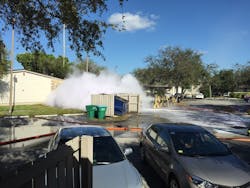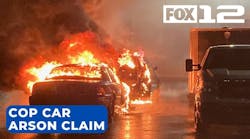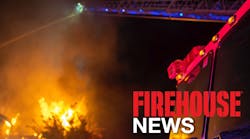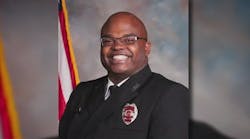A few months ago, Miami-Dade, FL, Fire Rescue (MDFR) Chief Dave Downey shared with me some incredible pictures that underscore the lesson that what we initially size-up may not be the ultimate hazard we face on scene. In this case, crews responded to a fire in a van that wasn’t anything close to be an ordinary vehicle fire—and it’s not the first time crews have been in this situation.
About Miami-Dade Fire Rescue
MDFR is one of the 10 largest fire-rescue departments in the United States, with an annual operating budget of $361 million and a $54 million 5-year capital plan. MDFR is staffed by 2,429 employees of which almost 2,000 are uniformed firefighters. The department covers 1,883 square miles, answering 290,000 calls annually out of 68 stations.
In addition to providing “traditional” fire rescue services, MDFR is a founding member of FEMA's National Urban Search and Rescue Response System. The department responds to natural and manmade disasters around the world, and assists with search and rescue, medical support, damage assessment and communications. It also operates four helicopter air-rescue units. Perhaps most interestingly, it runs the world’s only fire service-based venom unit, specializing in the response, management and treatment of envenomation.
Van on fire
On Jan. 24, 2017, MDFR units responded to a report of an unoccupied van fire in the parking lot of a multi-family complex. The first-arriving engine company found fire showing from the passenger window and the open driver door of the van. The company officer made contact with a bystander who advised that he was the 9-1-1 caller but he did not know who owned the vehicle.
At this point, the crew did not suspect anything more than a “typical” van fire. The apparatus was positioned in front of the van, and the unit officer ordered his crew to deploy the front bumper 1¾-inch preconnect hoseline.
While the crew began stretching the hose, the company officer began a counterclockwise 360 size-up of the van. During his 360, he noticed that he could not see into the rear windows of the van because they appeared to be painted black. The officer rejoined his crew and they began to attack the fire showing from the front windows.
Once fire conditions began to improve, the crew tried using hand tools to open the side cargo doors. Not knowing that the doors were fortified on the inside, the crew had no success forcing the doors conventionally with hand tools. Next, they attempted to use a rotary saw with a metal cutting blade.
About 30 seconds into using the saw, the fire flashed. At that point, the officer requested a second handline to attack the fire from the rear. He also ordered a different crew on scene to force the rear doors with hand tools, but they were unsuccessful.
While the firefighters were attempting to force the rear doors, the fire flashed again, nearly engulfing the two firefighters at the rear doors of the van.
Crews continued to battle a fire that would vacillate between improved conditions and sudden increases in size and intensity. They continued to attack the fire and protect exposures with foam, and eventually extinguished the fire with dry chemical supplied by an airport foam truck.
Incident considerations from MDFR
Turns out that there was nothing “typical” about this van fire. The van was carrying more than 250 gallons of gasoline in two large plastic containers (aka "bladders") designed to contain soap or other noncombustible liquids. According to Miami-Dade police, the transport of large quantities of stolen gasoline and diesel fuel in illegal bladder vehicles is increasing in the area.
There are incidents where firefighters operate at great risk because they are not fully aware of the dangers they face. This was the case with this van fire, as firefighters had no way of knowing that the van contained hundreds of gallons of stolen gasoline.
If your size-up makes you suspect that you are dealing with a vehicle that is illegally transporting fuel, there are several points to consider:
- Ensure the police department is responding, if they are not on scene already.
- If a vehicle owner is not on scene or is witnessed fleeing the scene, be suspect that something is not right.
- Be prepared for a potential of a three-dimensional rolling fuel fire that can suddenly grow in size and intensity.
- Position your apparatus uphill/up wind of the suspected vehicle.
- Ensure that your apparatus has an escape route for emergency retreat if necessary.
- Isolate and deny entry to all areas downhill/downwind of the suspected vehicle.
- Evacuate all vehicles and buildings downhill of the vehicle.
- Remember that water will be ineffective in controlling all but a very small amount of burning gasoline or diesel fuel, and water can also intensify and spread a rolling fuel fire.
- If firefighters direct their hoseline stream into the cargo area of a truck or passenger compartment of a minivan or SUV and the fire suddenly intensifies or grows, they should suspect the vehicle is carrying an additional fuel load and should stop applying water directly to the fire.
- Understand the capabilities of your apparatus on-board foam systems and in-line foam eductors; 125 gpm flow of foam solution will be ineffective on spill fires larger than 1,200 square feet.
- If there are structures nearby, request the appropriate building assignment, as well as a hazmat unit. You might also consider calling for an airport foam unit and/or ARFF apparatus if available.
- Use at least 150 feet of attack hose to ensure that the fire apparatus is in a safe position as well as an adequate distance from the vehicle.
- Attempt to collect as many dry chemical extinguishers from units on scene as possible to fight this potential three-dimensional fire.
- Be mindful of run off, in terms of where personnel are standing or operating (ignition could happen at any moment) as well as into storm drains (notify environmental officials and water and sewer departments).
Analysis from Chief Goldfeder
When I first saw the photos and video of this incident, my reaction was surprise but not shock. These days, more than ever, we never really know what we are turning out to. Size-up has NEVER been more critical—as well as one other factor: turnouts.
Turnouts, bunker gear, PPE, fire gear (or whatever you call it), along with SCBA, made a difference to the MDFR members operating at this incident. The fact that crews were wearing their gear shows that the crews, led by their officers, were well disciplined and there was no question about whether they would follow their standard operating procedures.
There was a time when a vehicle fire like this would show firefighters not using SCBA and not being geared-up from head to toe. Thankfully, those days continue to diminish.
So why did the MDFR firefighters gear up as they did? Why were they unharmed when the gasoline engulfed them? I think there are a few reasons.
Discipline: Simply put, there are some fire departments where operating recklessly is not tolerated in the culture. From training to leadership, the members KNOW how they will and are expected to operate. They have learned from themselves and others. As they say, it’s a “no brainer.” After all, why would anyone WANT to breathe that crap or get burned for no reason?
Cancer: Unfortunately, firefighter occupational cancer is a significant issue at MDFR. Every member of MDFR knows at least someone on the job who has or had an occupational cancer. Chief Downey shared the following: “We’re seeing firefighters in their 30s developing cancers that you don’t normally see in people until they are much older. We lost six people to brain cancer in 18 months. All of them were under 55.”
My friend Keith Tyson is a retired Miami-Dade firefighter and head of the Firefighter Cancer Support Network in Florida. Tyson has spent hundreds, if not thousands, of hours reviewing data and documenting the cases … and in some cases, the death certificates. He knows how horrible it can be, as he has been diagnosed with prostate and skin cancers.
Need proof?
MDFR researchers reached out to United HealthCare for data, and the numbers provided were staggering. Between 2008 and 2010, out of the approximately 2,000 MDFR members insured by United HealthCare, 32 percent (young personnel!) had already been diagnosed with some form of cancer. You simply cannot be a member of MDFR without understanding the impact that cancer has had and continues to have on them.
And while I have your attention: CLEAN YOUR GEAR!
There are more toxins and carcinogens present in the today’s fire environment than in the fires of previous years and generations. You as a firefighter have significantly increased chances of testicular, breast, prostate, brain, colon and thyroid cancer as well as non-Hodgkin’s lymphoma and melanoma.
So get that crap off of your gear and you as soon as you are able to—after every fire where there was smoke present. Period. Clean up (gross decontamination) at the scene when possible, and always shower clean in quarters.
And for the volunteers and call firefighters: Don’t spread that crap in your car, home and to your family. Clean up at the firehouse and keep a spare set of clothes just for that purpose. Remember, the stuff on your gear, your skin and in your system builds up over time. It doesn't just go away.
You as a firefighter need the self-discipline to CLEAN. You as a fire officer must create the no-excuses environment to ensure that your members know that the clean-up is the same as hose-rolling and SCBA-filling after a fire. You as a chief must create an environment of education, training and corrective actions to force the culture change. Part of that environment may be to have your firefighters visit a firefighter with cancer. Reach out to the Firefighter Cancer Support Network or MDFR; they have more cancer horror stories to share than they care to have. Do whatever it takes.
Avoid the two burns
The disciplined/no excuse/no BS use of head-to-toe PPE will help minimize the "two burns.” The first burn is the obvious—when heat and fire hits your skin and physically burns you. If you are lucky, it will bubble up and require minimal treatment. But odds are, if it's like this fire or other fires that firefighters typically go to, without PPE, you will have burned lungs, burned skin, an ambulance ride (that you may or may not remember), a flight to the burn unit, lots of tubes, skin scraping—all of which you REALLY want to avoid.
The second burn is the one that comes a few years later. It’s the cancer treatment burns. The radiation impact. The chemo impact. The surgical impact. The physical burns. The side effects. The damage from the disease itself. There’s no need to further describe what it's like. Google it. Or better yet, talk to a firefighter who has or had cancer. Odds are you know several.
While no PPE completely protects us from burns or cancer, your PPE is extremely effective in minimizing what exposures you will encounter as a firefighter. In this case, if the MDFR firefighters had NOT been on air and using their full PPE, you would be reading a much different story.
Our sincere thanks to the members of MDFR for their assistance with this article. In particular, thanks to Chief of Department Dave Downey, Chief of Safety Humberto Quintela and Captain Ernie Jillson for their assistance.






